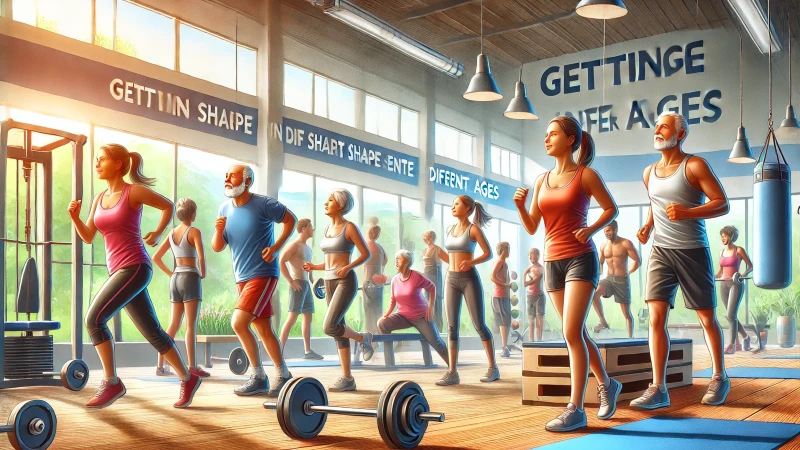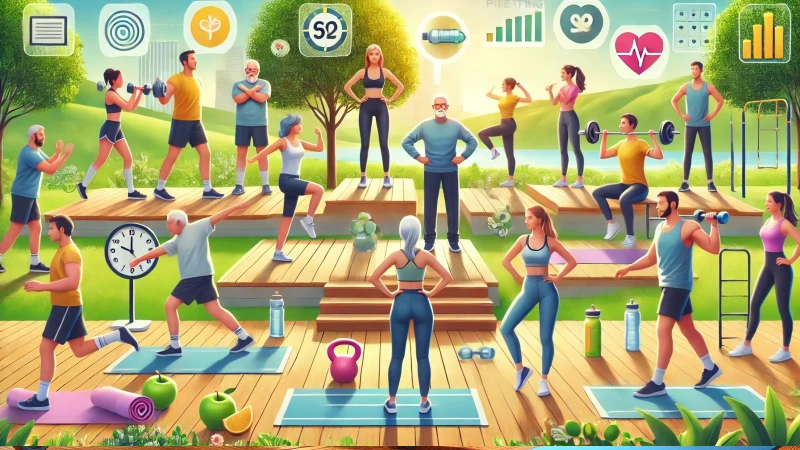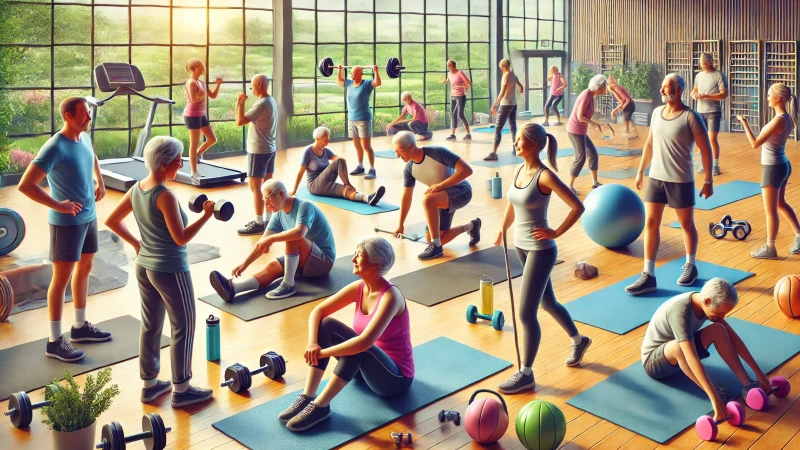Many people wonder if they are too old to start working out or improving their fitness. The simple answer is: Absolutely not! No matter your age, getting in shape is possible and beneficial. Whether you’re in your 20s, 40s, 60s, or beyond, it’s never too late to make positive changes to your health and fitness. The key is to find the right approach that suits your age, body, and lifestyle.
The Benefits of Fitness at Any Age
Regardless of when you start, exercise and a healthy lifestyle offer numerous benefits, including:
- Improved Heart Health – Regular exercise strengthens the heart and reduces the risk of heart disease.
- Better Mobility and Flexibility – Stretching and movement help maintain joint health and prevent stiffness.
- Stronger Muscles and Bones – Strength training can prevent osteoporosis and muscle loss as you age.
- Increased Energy Levels – Exercise helps combat fatigue and keeps you feeling more energized throughout the day.
- Enhanced Mental Health – Physical activity releases endorphins, reducing stress, anxiety, and depression.
- Weight Management – Staying active helps with weight control and maintaining a healthy metabolism.
- Improved Sleep Quality – Exercise can help regulate sleep patterns and improve overall restfulness.
- Better Cognitive Function – Regular physical activity has been linked to a lower risk of dementia and improved memory retention.
Getting in Shape at Different Ages

In Your 20s and 30s: Building a Strong Foundation
This is often the best time to develop lifelong fitness habits. Your body is more resilient, and you can push yourself to try different workouts, including:
- High-intensity interval training (HIIT)
- Strength training and weightlifting
- Endurance activities like running, cycling, and swimming
- Yoga and flexibility exercises to prevent injuries
- Functional training to enhance overall body coordination
In Your 40s and 50s: Maintaining and Adjusting
At this stage, metabolism slows down, and muscle loss begins, making strength training more important than ever. Recommended workouts include:
- Resistance training with weights or bodyweight exercises
- Cardio exercises such as brisk walking, jogging, or rowing
- Core workouts to protect your back and improve posture
- Yoga or Pilates for flexibility and mobility
- Circuit training for an effective mix of cardio and strength-building
In Your 60s and Beyond: Prioritizing Mobility and Strength
Aging doesn’t mean giving up on fitness—it means adapting. Gentle but effective workouts include:
- Low-impact cardio like walking, swimming, or cycling
- Light strength training to preserve muscle mass
- Balance exercises to prevent falls (tai chi, yoga)
- Stretching and flexibility workouts to maintain movement
- Chair-based exercises for those with limited mobility
Overcoming Common Fitness Myths About Age
Myth #1: Older Adults Shouldn’t Lift Weights
Reality: Strength training is one of the best ways to combat muscle loss and maintain bone density. Using resistance bands or light weights can make a big difference.
Myth #2: It’s Too Late to Start Exercising
Reality: Studies show that even people in their 70s and 80s can build muscle and improve cardiovascular health through exercise.
Myth #3: Cardio is the Only Exercise You Need
Reality: While cardio is important for heart health, strength training and flexibility exercises are just as essential for maintaining overall function and mobility.
Myth #4: You Have to Exercise Every Day for Hours
Reality: Short, consistent workouts are more effective than long, sporadic ones. Even 20-30 minutes of daily activity can yield significant health benefits.
Tips for Getting in Shape at Any Age

- Start Slowly – Don’t overdo it. Begin with low-intensity workouts and gradually increase the challenge.
- Listen to Your Body – Pay attention to any pain or discomfort and modify exercises accordingly.
- Stay Consistent – Regular exercise is more important than intensity. Aim for at least 30 minutes a day.
- Eat a Balanced Diet – Proper nutrition supports muscle growth, recovery, and overall health.
- Get Enough Rest – Recovery is key, especially as you age. Ensure you get quality sleep and rest days.
- Stay Hydrated – Drink plenty of water to keep your body functioning optimally.
- Find Activities You Enjoy – The best workout is the one you’ll stick to. Whether it’s dancing, hiking, or yoga, choose something fun.
- Set Realistic Goals – Focus on progress, not perfection. Small, steady improvements lead to lasting results.
- Consider Professional Guidance – A personal trainer or fitness coach can help tailor a workout plan suited to your age and ability level.
- Use Technology to Your Advantage – Fitness apps, smartwatches, and online workout programs can help track progress and keep you motivated.
How to Stay Motivated on Your Fitness Journey
- Find a Workout Partner – Exercising with a friend or family member can make workouts more enjoyable and hold you accountable.
- Join a Community – Group fitness classes or online fitness groups can provide encouragement and support.
- Celebrate Small Wins – Acknowledge progress, whether it’s lifting heavier weights, walking longer distances, or feeling more energetic.
- Mix It Up – Trying new workouts can prevent boredom and keep things exciting.
- Track Your Progress – Keeping a journal or using a fitness tracker can help you see improvements over time.
- Focus on Non-Scale Victories – Success isn’t just about weight loss—it can also be about increased stamina, better mood, or improved sleep quality.
The Role of Mental Health in Fitness
Staying in shape isn’t just about physical activity—it’s also about mental well-being. Exercise has been proven to:
- Reduce symptoms of anxiety and depression
- Improve focus and concentration
- Boost self-confidence and self-esteem
- Enhance overall emotional resilience
Practicing mindfulness, meditation, and stress management techniques alongside physical exercise can further enhance overall well-being.
Conclusion: It’s Never Too Late to Get Fit
No matter your age, getting in shape is achievable and rewarding. The key is to start where you are and progress at your own pace. Fitness isn’t just about aesthetics—it’s about improving your quality of life, energy levels, and overall well-being. Whether you’re 25 or 75, the best time to start is now.
If you’ve been hesitating to begin your fitness journey, remember: Every step counts, and every age is the right age to start!
Many people wonder if they are too old to start working out or improving their fitness. The simple answer is: Absolutely not! No matter your age, getting in shape is possible and beneficial. Whether you’re in your 20s, 40s, 60s, or beyond, it’s never too late to make positive changes to your health and fitness. The key is to find the right approach that suits your age, body, and lifestyle.
The Benefits of Fitness at Any Age

Regardless of when you start, exercise and a healthy lifestyle offer numerous benefits, including:
- Improved Heart Health – Regular exercise strengthens the heart and reduces the risk of heart disease.
- Better Mobility and Flexibility – Stretching and movement help maintain joint health and prevent stiffness.
- Stronger Muscles and Bones – Strength training can prevent osteoporosis and muscle loss as you age.
- Increased Energy Levels – Exercise helps combat fatigue and keeps you feeling more energized throughout the day.
- Enhanced Mental Health – Physical activity releases endorphins, reducing stress, anxiety, and depression.
- Weight Management – Staying active helps with weight control and maintaining a healthy metabolism.
- Improved Sleep Quality – Exercise can help regulate sleep patterns and improve overall restfulness.
- Better Cognitive Function – Regular physical activity has been linked to a lower risk of dementia and improved memory retention.
Getting in Shape at Different Ages
In Your 20s and 30s: Building a Strong Foundation
This is often the best time to develop lifelong fitness habits. Your body is more resilient, and you can push yourself to try different workouts, including:
- High-intensity interval training (HIIT)
- Strength training and weightlifting
- Endurance activities like running, cycling, and swimming
- Yoga and flexibility exercises to prevent injuries
- Functional training to enhance overall body coordination
In Your 40s and 50s: Maintaining and Adjusting
At this stage, metabolism slows down, and muscle loss begins, making strength training more important than ever. Recommended workouts include:
- Resistance training with weights or bodyweight exercises
- Cardio exercises such as brisk walking, jogging, or rowing
- Core workouts to protect your back and improve posture
- Yoga or Pilates for flexibility and mobility
- Circuit training for an effective mix of cardio and strength-building
In Your 60s and Beyond: Prioritizing Mobility and Strength
Aging doesn’t mean giving up on fitness—it means adapting. Gentle but effective workouts include:
- Low-impact cardio like walking, swimming, or cycling
- Light strength training to preserve muscle mass
- Balance exercises to prevent falls (tai chi, yoga)
- Stretching and flexibility workouts to maintain movement
- Chair-based exercises for those with limited mobility
Overcoming Common Fitness Myths About Age
Myth #1: Older Adults Shouldn’t Lift Weights
Reality: Strength training is one of the best ways to combat muscle loss and maintain bone density. Using resistance bands or light weights can make a big difference.
Myth #2: It’s Too Late to Start Exercising
Reality: Studies show that even people in their 70s and 80s can build muscle and improve cardiovascular health through exercise.
Myth #3: Cardio is the Only Exercise You Need
Reality: While cardio is important for heart health, strength training and flexibility exercises are just as essential for maintaining overall function and mobility.
Myth #4: You Have to Exercise Every Day for Hours
Reality: Short, consistent workouts are more effective than long, sporadic ones. Even 20-30 minutes of daily activity can yield significant health benefits.
Tips for Getting in Shape at Any Age
- Start Slowly – Don’t overdo it. Begin with low-intensity workouts and gradually increase the challenge.
- Listen to Your Body – Pay attention to any pain or discomfort and modify exercises accordingly.
- Stay Consistent – Regular exercise is more important than intensity. Aim for at least 30 minutes a day.
- Eat a Balanced Diet – Proper nutrition supports muscle growth, recovery, and overall health.
- Get Enough Rest – Recovery is key, especially as you age. Ensure you get quality sleep and rest days.
- Stay Hydrated – Drink plenty of water to keep your body functioning optimally.
- Find Activities You Enjoy – The best workout is the one you’ll stick to. Whether it’s dancing, hiking, or yoga, choose something fun.
- Set Realistic Goals – Focus on progress, not perfection. Small, steady improvements lead to lasting results.
- Consider Professional Guidance – A personal trainer or fitness coach can help tailor a workout plan suited to your age and ability level.
- Use Technology to Your Advantage – Fitness apps, smartwatches, and online workout programs can help track progress and keep you motivated.
How to Stay Motivated on Your Fitness Journey
- Find a Workout Partner – Exercising with a friend or family member can make workouts more enjoyable and hold you accountable.
- Join a Community – Group fitness classes or online fitness groups can provide encouragement and support.
- Celebrate Small Wins – Acknowledge progress, whether it’s lifting heavier weights, walking longer distances, or feeling more energetic.
- Mix It Up – Trying new workouts can prevent boredom and keep things exciting.
- Track Your Progress – Keeping a journal or using a fitness tracker can help you see improvements over time.
- Focus on Non-Scale Victories – Success isn’t just about weight loss—it can also be about increased stamina, better mood, or improved sleep quality.
The Role of Mental Health in Fitness
Staying in shape isn’t just about physical activity—it’s also about mental well-being. Exercise has been proven to:
- Reduce symptoms of anxiety and depression
- Improve focus and concentration
- Boost self-confidence and self-esteem
- Enhance overall emotional resilience
Practicing mindfulness, meditation, and stress management techniques alongside physical exercise can further enhance overall well-being.
Conclusion: It’s Never Too Late to Get Fit
No matter your age, getting in shape is achievable and rewarding. The key is to start where you are and progress at your own pace. Fitness isn’t just about aesthetics—it’s about improving your quality of life, energy levels, and overall well-being. Whether you’re 25 or 75, the best time to start is now.
If you’ve been hesitating to begin your fitness journey, remember: Every step counts, and every age is the right age to start!

